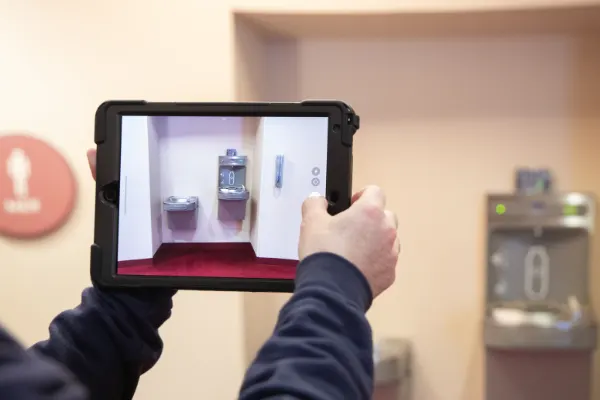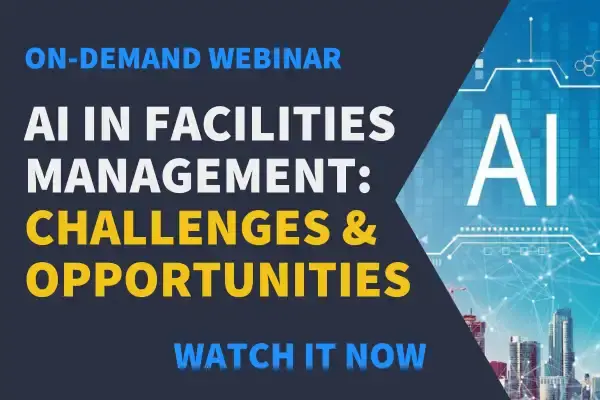AI Insights: How AI Can Support the Facilities Teams of the Future
This is the third in an ongoing series of articles exploring the intersection of artificial intelligence (AI) and facilities management (FM). As AI plays an ever larger role in FM, this series helps facility industry professionals understand and leverage AI to build a brighter future. Read the first article here. Read the second article here.
Every facilities manager’s worst nightmare probably looks something like this video.
In December 2023, Phil Miller encountered flooding water in the Ohio Statehouse Senate chamber. (Phil is the chief operating officer and assistant director of the Capitol Square Review and Advisory Board for the Ohio Statehouse.)
Water was pouring from the ceiling, covering the floor, and rapidly finding its way down the stairs to the two levels beneath. It caused quite a stir and even made national news. Nobody likes experiencing a facility emergency so bad it ends up on TV.
The culprit? Weather. A cold snap with sustaining winds of over 40 miles per hour caused wind chill temperatures between 30 and 40 degrees below zero. On the northern side of the building, where the Senate chambers are, an air handling unit in the attic got too cold and a fire suppression pipe broke. A few days later, as things started to thaw out, the Senate chambers flooded.
Determining what happened and why was a fairly straightforward exercise. But the question Phil kept asking himself was: what could we have done to prevent this? What could we have been doing differently?
He couldn’t help but wonder if AI may have helped the Ohio Statehouse team avoid the situation altogether. Perhaps with an automated notification based on the current weather combined with the attic temperature. By knowing that information ahead of time, the team could have taken proactive steps to ensure the attic temperature stayed warm enough to prevent freezing.
With AI becoming more of a reality in facilities management, many building operators are asking themselves the same questions Phil is. Can AI help me be more proactive? Gain efficiencies? Prevent costly malfunctions? And how do I start leveraging AI to help me do all those things?
Phil joined AkitaBox’s Josh Lowe to discuss these very topics in a recent Facility Executive webinar titled “AI in Facilities Management: Challenges & Opportunities.”
You can watch the complete webinar here.
Just want the cliff notes? Keep reading for key insights from the webinar, including AI’s role in data collection and proactive maintenance, as well as tips for getting started with AI.
AI’s #1 Benefit: Data Collection
Facility managers have struggled with data for years. It’s critically important in making decisions, but it’s a double-edged sword. Spending time collecting and managing data can potentially take away from the time needed to actually manage the facilities. Balancing the time spent on both actions is important.
Over the last two decades, data has become an even more prominent need. Facility managers use it to justify budgets, purchases, and capital improvements, as well as the acquisition and disposition of property. Data is critically important, but it has to be managed properly.
”“We’re entering a stage of history where the amount of human knowledge is expanding exponentially. AI is a human invention to deal with our human problem of having too much data."
Josh Lowe
One of the biggest ways AI can make a positive impact in the realm of facilities data is by improving the actual collection of data in the first place. Consider this scenario.
What if all you had to do is walk up to an asset and take pictures of the asset itself and any identifying information like manufacturer name plates? From those photos, AI could tell you what type of equipment it is, its size, and any other pertinent information like make, model, serial number, and manufacturer. It could even tell you roughly what condition that asset is in.

Without AI, the process of taking photos, looking over the asset, gauging condition, taking notes, and entering all that data into your FM system takes a fair amount of time. And putting boots on the ground to collect data isn’t cheap. But with the help of AI, your field technicians can become lean, mean data collecting machines – constantly feeding AI the data points it needs to provide you with useful asset information.
Leveraging AI to Shift from Reactive to Proactive Maintenance
”“In facility management, many of us spend a lot of time in the reactive world by virtue of our very tight budgets and limited resources. And we all dream of the day where we can be spending a majority of our time in the preventive maintenance world.”
Phil Miller
AI is a tool for both reactive and proactive activities. In fact, the data from reactive actions can inform your proactive practices. For example, your data tells you that at 100 hours of runtime or three months of service, a specific asset always fails. That’s a reactive data point that AI can track and use to help you be more proactive going forward. The more data you collect and track using AI, the more equipped you’ll be to take proactive action at the right time.

Phil shares this illustration. The elevators in the Statehouse are now between 25 and 30 years old, so all the components for fixing those elevators are no longer manufactured and available. “What if I got that information proactively, telling me that this equipment is no longer available? Do I start thinking about capital planning?”
Or another scenario: You have 26 of a particular type of air handler. They’re all from the same manufacturer and you have to go west of the Mississippi just to find one of these things. And it’s going to take you eight weeks to get it.
“How do you deal with that situation?” asks Phil. “What if AI provided you that information before you even asked the question? Makes you wonder.”
Where Should You Start with AI?
A solid first step is getting your baseline of facilities data. Know what assets you have, their specs, and where they’re located. Then look at what other data you may have that could feed into AI. Do you have data from a building automation system (BAS)? What about failure logs? Start organizing and pulling together whatever facilities data you have.
Next, play around with AI. Yes, you can play around with it. Create an account on ChatGPT or Google Bard and start exploring. Ask it questions. Give it an input and see what sort of output you get. Have it create a spreadsheet of data for you based on a topic you’d like to learn about. Start getting a feel for the power and potential of AI.

Approach AI with an Open Mind
The FM industry realizes AI is coming. But there’s still a lot we as an industry are learning about AI and how it can help us. So be willing to explore technology like AI that can help us do a better job.
“Most facility managers are dealing with budgets that are getting smaller, and expectations and costs that are getting bigger,” says Phil. “It’s a widening chasm we’re dealing with every day.
“We have to be open to constant improvement. Not change for the sake of change, but a willingness to adapt, be resilient, be nimble in our organizations. How can we use new technologies like AI in our workplace to help us be more productive and position ourselves for the future?”
Watch the full webinar anytime here. Interested in a deeper discussion on AI? Want to learn how AI-enabled software like AkitaBox can support your facilities team? Give us a shout!
